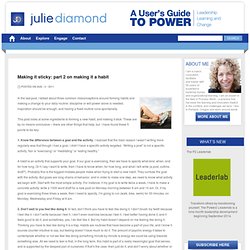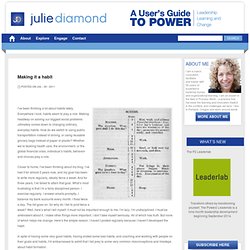

A Simple Exercise to Help You Get Unstuck - Teresa Norton. By Teresa Norton | 8:00 AM July 25, 2012 Winston Leung came into my office a tense and frustrated fellow.

He knew he needed to do things differently but he didn’t want to change who he was. He was visibly relieved to hear that the goal of our work together was just that — to adjust the ‘do’ not the ‘who’. He had been recently moved into a position that had been held for almost 20 years by a much older man who, upon retiring, had left what Winston and others in the company perceived as enormous shoes to fill. This former boss had been a strong, charismatic father figure to the team that Winston inherited and was a no-nonsense negotiator with internal clients who perceived as Winston ‘too nice’.
Winston was an interesting dichotomy — conflict averse and overly eager to ‘get along’ with those he perceived as his superiors while dictatorial and unable or unwilling to address the needs of his overworked team. The next week he came in with a pretty significant insight. A User's Guide to Power. This is the third, and probably last for now, in a series of posts on habits.

The last post I focused on creating new habits, and how to make them sticky. This one is about breaking a habit, or, to stay with the same theme, unsticking a habit. This is far more complex because un-learning something involves more analysis and more steps than simply doing something new. Primarily, to un-stick a habit, you first have to hack it. You have to investigate the eco-system of behaviors surrounding the habit. 1. With her snacking, it turned out she was tired and snacked for more energy. This is also known as removing the trigger. 2. 3. Stopping a habit is hard, and figuring out if you’re stopping the right thing if a good first step. Making it sticky: part 2 on making it a habit.
In the last post, I talked about three common misconceptions around forming habits and making a change to your daily routine: discipline or will power alone is needed; inspiration should be enough, and having a fixed routine ruins spontaneity.

This post looks at some ingredients to forming a new habit, and making it stick. These are by no means conclusive – there are other things that help, but I have found these 5 points to be key. 1. Know the difference between a goal and the activity. I realized that the main reason I wasn’t writing more regularly was that though I had a goal, I didn’t have a specific activity targeted. A habit is an activity that supports your goal. 2. 3. 4. 5. Let me know what works or has worked for you. And for those of you who like thinking about this stuff, there’s a wonderful article in this month’s Bicycling Magazine called “90 Days,” on forming an exercise habit. A User's Guide to Power.
I’ve been thinking a lot about habits lately.

Everywhere I look, habits seem to play a role. Making headway on solving our biggest social problems ultimately comes down to changing ordinary, everyday habits. How do we switch to using public transportation instead of driving, or using reusable grocery bags instead of paper or plastic? Whether we’re tackling health care, the environment, or the global financial crisis, individual’s habits, behavior and choices play a role. Closer to home, I’ve been thinking about my blog. In spite of having some very good habits, having ended some bad habits, and coaching and working with people on their goals and habits, I’m embarrassed to admit that I fall prey to some very common misconceptions and missteps about habit formation.
So, this blog and the next couple will explore the tricky business of habits, stopping habits, and habit formation. 1. 2. There is some truth in there, but it doesn’t work that way. 3. I have a lot of spontaneous thoughts.